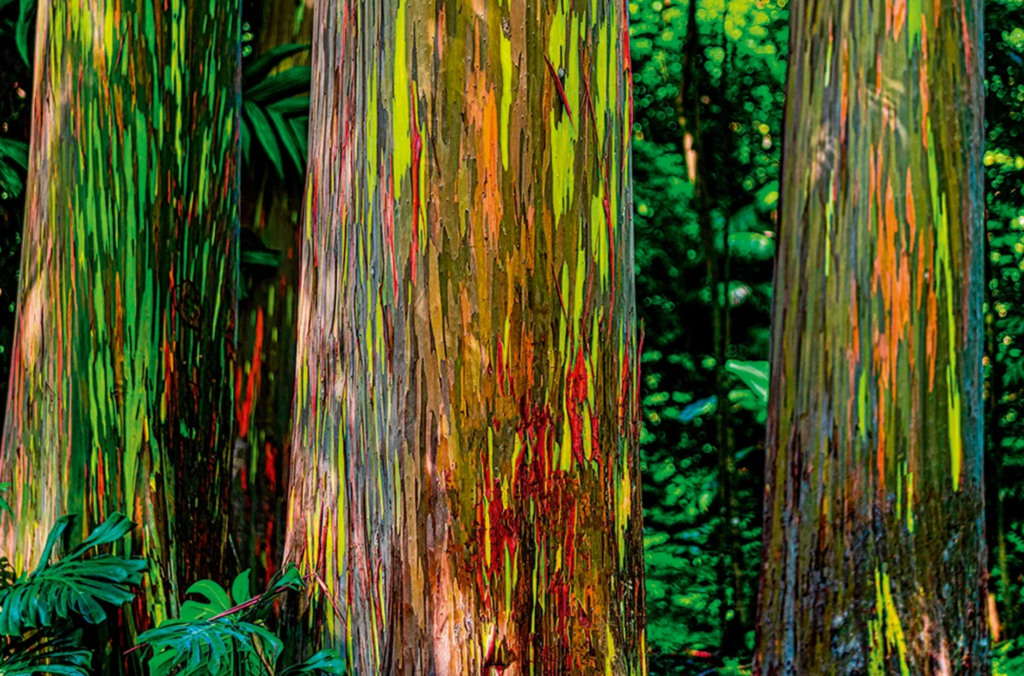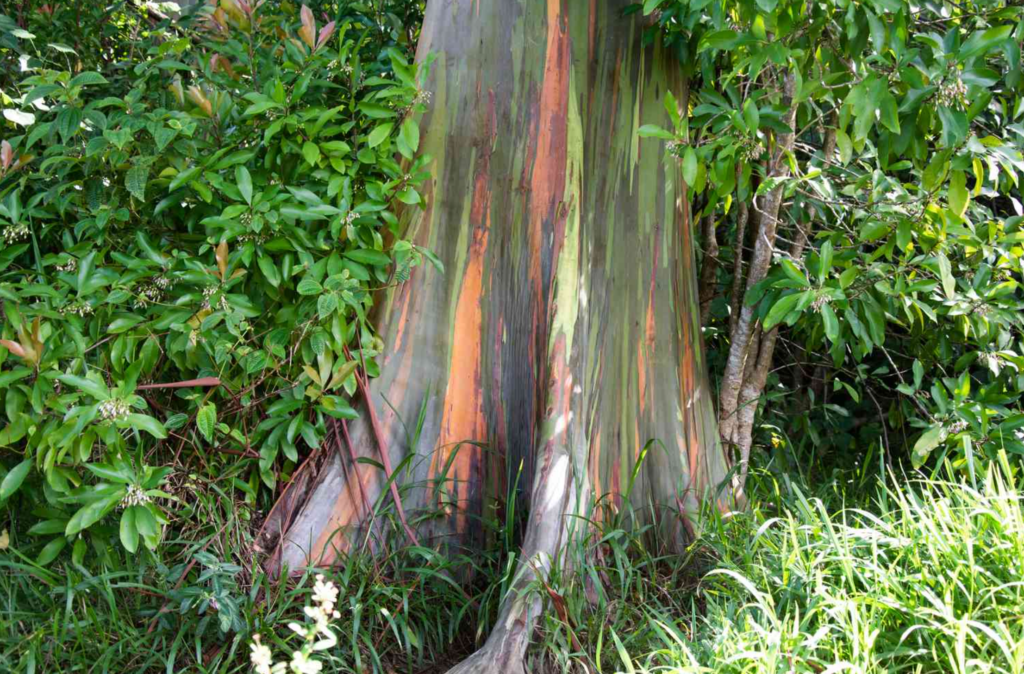Rainbow Tree: Have you ever seen a tree that looks like a rainbow? If you have, you might have encountered the rainbow eucalyptus, a remarkable tree that has neon stripes running along its trunk. This stunning tree is native to the Philippines, Indonesia, and Papua New Guinea, where it grows in tropical rainforests. It is also the only eucalyptus species that is found in the northern hemisphere.
Rainbow Tree
But how does this tree get its colorful appearance? The secret lies in its bark, which sheds in thin layers throughout the year. Unlike other trees, which have a uniform color of bark, the rainbow eucalyptus has a green inner bark that changes color as it ages. When the outer layer of bark peels off, it reveals the bright green inner layer, which is rich in chlorophyll, the pigment that gives plants their green color. As the inner bark is exposed to sunlight and air, it gradually turns blue, purple, orange, red, and yellow, creating a spectrum of hues. The colors are not uniform, but rather vary depending on the age and location of the bark. The result is a patchwork of colors that resembles a rainbow.
Also read : Africa May Split Into Two Continents And Perhaps Open Up Into A New Ocean

Rainbow Tree
The rainbow tree eucalyptus is not only beautiful, but also useful. It is widely cultivated for its pulpwood, which is used to make paper. It is also valued for its fast growth, tolerance to drought, and resistance to pests and diseases. However, it is also considered an invasive species in some regions, such as Hawaii and Florida, where it can outcompete native plants and disrupt the ecosystem. Therefore, it is important to plant and manage this tree responsibly and sustainably

Rainbow Tree
The rainbow eucalyptus is a fascinating example of how nature can produce amazing colors and patterns. It is also a reminder of the diversity and beauty of the plant kingdom, which we should appreciate and protect. The next time you see a rainbow, you might wonder if there is a rainbow eucalyptus nearby
FAQ
Q: What is the ‘rainbow’ tree, and why is it called that?
A: The ‘rainbow’ tree, scientifically known as the rainbow eucalyptus (Eucalyptus deglupta), is a tree native to the Philippines, Indonesia, and Papua New Guinea. It is called the ‘rainbow’ tree due to its striking bark that displays a vibrant array of colors, resembli
Q: What causes the rainbow colors in the bark of this tree?
A: The colors in the rainbow tree eucalyptus bark result from a combination of environmental factors, chemistry, and the tree’s unique biology. As the bark sheds, the inner bark, initially green due to chlorophyll, transforms into various hues as it ages, influenced by pigments like tannins and environmental conditions.
Q: How does the bark of the rainbow eucalyptus change over time?
A: The bark undergoes a continuous cycle of shedding, revealing fresh, moist bark underneath. The colors in the bark evolve as it ages and is exposed to air and sunlight. Different sections of the trunk may exhibit various colors simultaneously, creating a visually dynamic display.
Q: Are sunlight and climate important factors in the coloration of the bark?
A: Yes, sunlight and climate play a crucial role. Regions with abundant sunlight and a tropical climate provide optimal conditions for the rainbow eucalyptus to showcase its full spectrum of colors. Environmental factors influence the intensity and range of colors in the bark.
Q: Are sunlight and climate important factors in the coloration of the bark?
A: Yes, sunlight and climate play a crucial role. Regions with abundant sunlight and a tropical climate provide optimal conditions for the rainbow eucalyptus to showcase its full spectrum of colors. Environmental factors influence the intensity and range of colors in the bark.
Q: How does the tree contribute to conservation efforts?
A: While the rainbow tree eucalyptus is commercially important, conservation efforts are essential to preserve its native habitats. Sustainable cultivation practices and conservation initiatives are crucial to protect the natural ecosystems where these trees thrive.
Q: Is the rainbow eucalyptus a symbol of anything?
A: The rainbow tree eucalyptus is symbolic of the diversity and beauty found in the natural world. Its ever-changing bark serves as a reminder of nature’s creativity and the intricate interplay of biological and environmental factors.
Q: Can the rainbow tree eucalyptus be grown in regions outside its native habitat?
A: Yes, the rainbow eucalyptus can be cultivated in various tropical and subtropical regions worldwide. Its adaptability to different climates makes it a popular choice for ornamental purposes in gardens and parks outside its native range
Q: Is there a need for conservation measures to protect the rainbow eucalyptus?
A: Yes, conservation measures are crucial to protect the rainbow eucalyptus and its native habitats. Deforestation and habitat destruction pose threats to the ecosystems where these trees thrive, emphasizing the importance of responsible cultivation and conservation practices.
Q: Where can I see a rainbow eucalyptus in its full glory?
A: Rainbow eucalyptus trees can be found in various tropical and subtropical regions, including the Philippines, Indonesia, Papua New Guinea, and cultivated areas worldwide. Botanical gardens and parks often feature these trees, providing opportunities to witness their stunning colors.
Also read : Top 10: Strongest Animals In The World




































